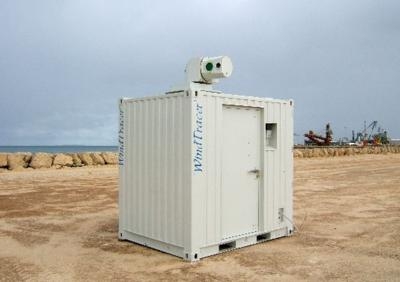Mon, Feb 18, 2013
Lidar Measurements Led To Reduction In Diagonal Spacing On Adjacent Runways
The FAA has applied hundreds of thousands of research measurements made by Lockheed Martin's WindTracer Doppler lidar to redefine flight rules, achieving major efficiency enhancements at U.S. airports.

The FAA granted approval for San Francisco International Airport (SFO) and Newark Liberty International Airport (EWR) to conduct dependent arrival operations on their closely spaced parallel runway (CSPR) pairs. SFO and EWR have joined a growing list of airports with CSPR geometries that are authorized by the Federal Aviation Administration to conduct a wake turbulence mitigation procedure for CSPR operation, known as FAA Order JO 7110.308 – Ch3. The safety assessment is enabled with significant amount of wake measurement research using WindTracer lidars.
The assessment permits reduced diagonal spacing of 1.5 nautical miles on adjacent runways relative to the leading large- and small-category aircraft with runway spacing less than 2500 feet under Instrument Flight Rules. Before the implementation of 7110.308, planes arriving on two such CSPRs were required to be spaced as if they were using a single runway, which effectively closed down one of the parallel runways under instrument conditions. This procedure at SFO and EWR is expected to reduce delays significantly.
"We are thrilled that the FAA has employed our WindTracer Doppler lidars to achieve these critical improvements to U.S. air traffic rules," said Dr. Michael Margulis, director of WindTracer Programs at Lockheed Martin. "These changes will greatly increase U.S. civil airspace capacity while maintaining the highest standards of air traffic safety."
The FAA Wake Turbulence Research Program has been using WindTracer systems since 2001 at multiple airport locations to conduct wake turbulence research measurements. The databases are carefully mined to provide data-driven assessment of ongoing and future wake turbulence mitigation concepts. In addition, wind data collection is also used to develop weather-based wake mitigation solutions.
The John A. Volpe National Transportation Systems Center, part of the U.S. Department of Transportation's Research and Innovative Technology Administration, maintains and operates a fleet of WindTracers for the FAA Wake Turbulence Research Program and provides data analysis and other resource supports.
(WindTracer image courtesy Lockheed Martin)
More News
From 2017 (YouTube Edition): ADS-B For Airplanes And Drones… ADS-B technology developed by uAvionix has come full circle. The company began with a device developed for manne>[...]
Dead Reckoning Dead reckoning, as applied to flying, is the navigation of an airplane solely by means of computations based on airspeed, course, heading, wind direction, and speed,>[...]
"The next great technological revolution in aviation is here. The United States will lead the way, and doing so will cement America’s status as a global leader in transportat>[...]
Aero Linx: The Mooney Mite Site Dedicated to the Mooney M-18 Mite, "The Most Personal Airplane," and to supporting Mite owners everywhere. The Mooney M-18 Mite is a single-place, l>[...]
Also: Space Command Moves, Alpine Eagle, Duffy Names Amit Kshatriya, Sikorsky-CAL FIRE Collab Textron eAviation is putting the development of its Nexus electric vertical takeoff an>[...]
 Classic Aero-TV: UAvionix - Transitioning Between Manned & Unmanned Technologies
Classic Aero-TV: UAvionix - Transitioning Between Manned & Unmanned Technologies ANN's Daily Aero-Term (09.14.25): Dead Reckoning
ANN's Daily Aero-Term (09.14.25): Dead Reckoning Aero-News: Quote of the Day (09.14.25)
Aero-News: Quote of the Day (09.14.25) ANN's Daily Aero-Linx (09.14.25)
ANN's Daily Aero-Linx (09.14.25) Airborne-NextGen 09.09.25: Textron Nixes ePlane, Joby L/D Flt, Swift Approval
Airborne-NextGen 09.09.25: Textron Nixes ePlane, Joby L/D Flt, Swift Approval



